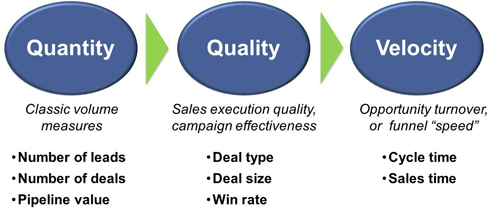Getting Back to Basics on Sales Process Analytics
When it comes to managing the sales process, it’s common to make one of two errors – under analyze, or over analyze. Under analyzing how your sales process is working can leave you with limited information, often resulting in decision making based on guesswork and gut feel. Over analyzing can provide lots of information (picture the 30-page “Pipeline Report” with slide after slide of detailed pie and funnel charts). But it can also be confusing and lead to “analysis paralysis.”
What is the answer?
There are seemingly hundreds of vendors pitching their wares to help in this area. If you’ve had “Vice President of Sales” in your title for more than a couple months, you’ve probably already been inundated by most of them offering you their tool, training program or “solution.” The space is crowded with messages that drone “use this approach and you’ll increase sales output by X percent.” And the bits of truth found within each choice add to the temptation and make navigating the way all the more confusing. Many leaders are driven to either sign up for more than they need or ignore them all and stick with what they’re used to doing.
Let’s get back to basics
Regardless of what CRM tool or sales process methodology you use, there are three primary metrics you should care about. Namely, deal quantity, quality and velocity.
Deal Quantity. These volume measures include the number of leads, the number of deals, and the value of the pipeline in terms of total or expected value for a specific period of time (daily, weekly, monthly, or quarterly). It’s hard to imagine running a sales team without these classic pipeline metrics. However, it’s easy to fall in to the trap of focusing exclusively on quantity metrics.
Deal Quality. Quality metrics are more difficult to measure but using them adds a critical lens to the effectiveness of the sales process. Are leads qualified effectively? Are deal sizes and types attractive? Close rate is the classic quality metric. Win/loss analysis can provide valuable insights into strengths and weaknesses of your sales effort and the advantages or shortcomings of your offerings. The main reason why quality metrics are so difficult to manage is doing so requires a well-defined, consistently executed sales process.
Deal Velocity. Deal velocity measures the “turnover” of deals, or the speed of the funnel. Once a lead shows up in the funnel, how quickly does it move through the process? How much time in both total duration and in actual rep selling hours does closing the deal require? You can gain valuable insights from assessing where deals get hung up in the process and what constraints, both internal and external, may be causing this. The number one shortfall for most sales forces is the reluctance to qualify out deals. Sales people tend to be eternal optimists. But “speed to failure,” i.e. walking away from deals that are not qualified is critical to deal velocity. If the average age of lost deals is significantly higher than won deals, you have a problem in this area. Analyzing this effectively also requires a well-defined and consistently executed sales process.
Benchmarks
Let’s assume for a moment that you effectively track all of the above metrics in a simple and concise fashion. The next obvious question is what level of performance should you expect? There are several data sources, surveys, and rules of thumb you will find. The classic rule of thumb I hear the most is “we expect 3x pipeline,” meaning the total pipeline value for a specific period of time (commonly one quarter) should equal three times the sales target for that same period. This might be directionally correct and useful. However, when it comes to sales process, the best benchmarks are internal. In other words, once you have a well-defined and consistently executed sales process you can track these measures month over month, quarter over quarter, and year over year, comparing them to actual sales results. This will yield the insight to determine what is desired or necessary for your business.
Interested in learning more? Contact the Alexander Group to learn how to effectively design, manage and measure your sales process.
Learn more about Alexander Group’s Sales Analytics practice.
